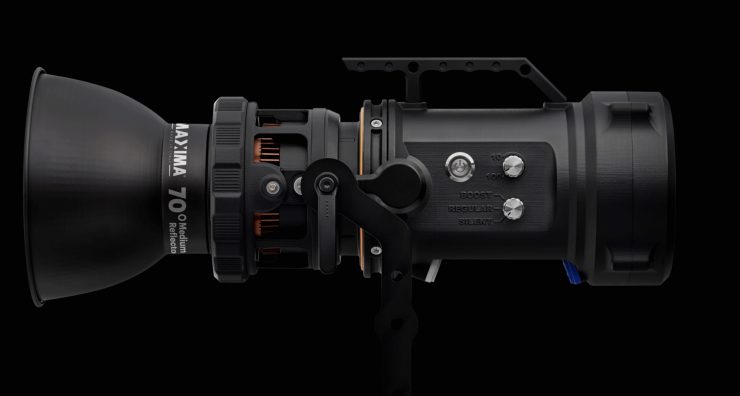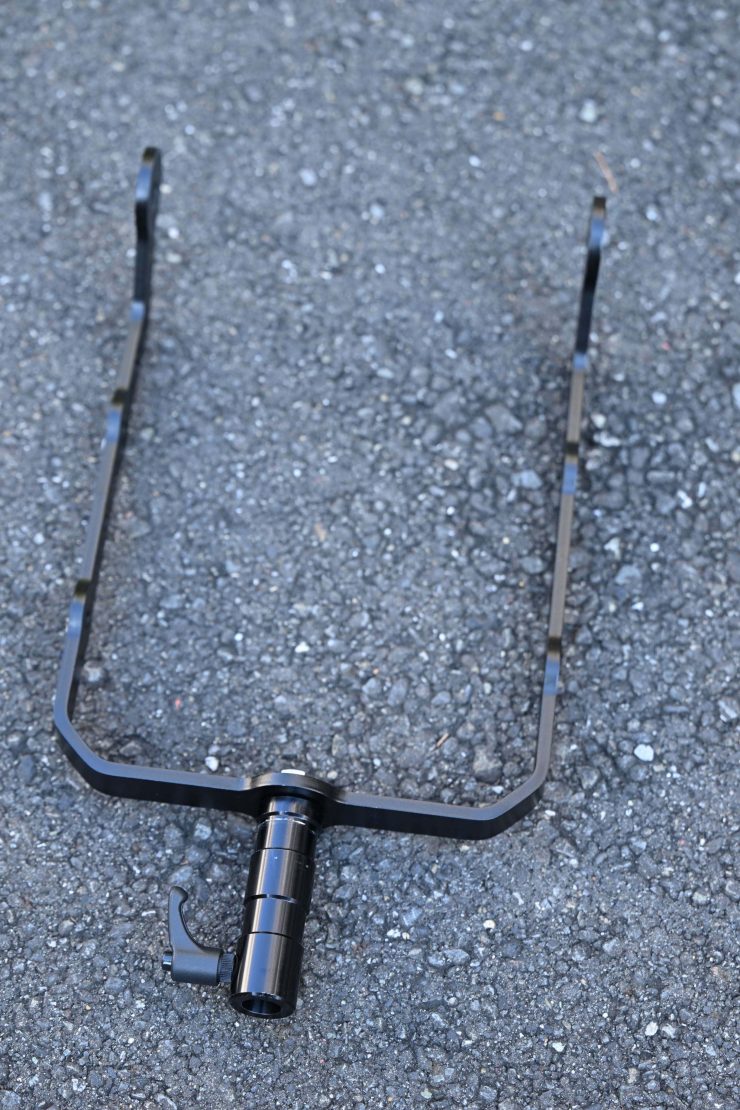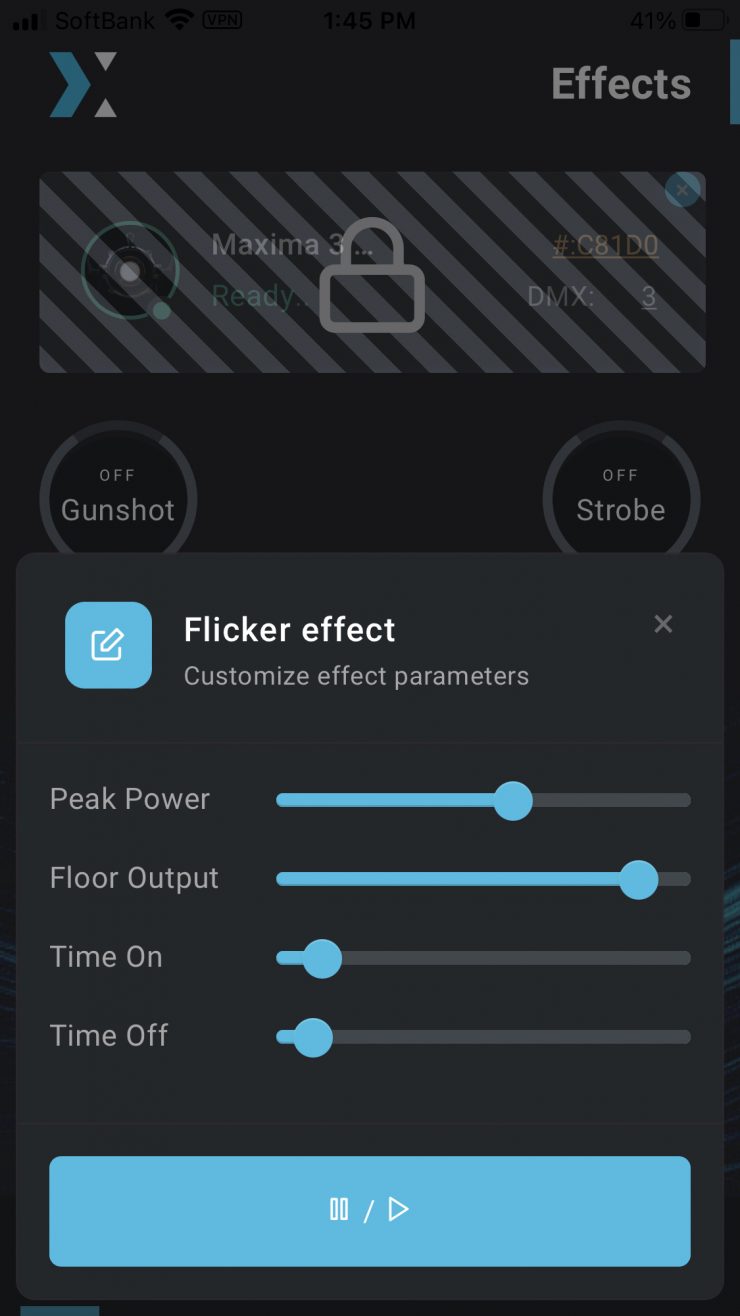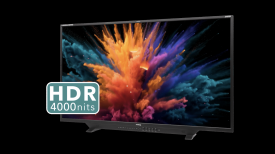
The Maxima 6 GaN is claimed to produce more than 60,000 lumens in the same, all-in-one convenient form factor as the original Maxima 3. It also has the same high color accuracy (98.3 CRI) with superior cooling technology and all-weather resistance. The Maxima 6 GaN is being touted as an extremely bright and compact, directional LED fixture with an output comparable to that of conventional technology 700W LEDs.

The company is also claiming that it has the quietest noise footprint in the market (although that is a big claim). According to Maxima, all of this was made possible by adopting next-gen Gallium Nitride (GaN) circuitry. At least to my knowledge, this is the first time ever this has been used with lighting equipment in our industry.

I was excited to review this fixture because I like innovation and new technology. Innovation with LED lighting has arguably been lacking in the last few years, with a lot of copycat fixtures flooding the market.
Key features
- 4kg weight, all-in-one compact design with no external ballast
- Noiseless operation
- 69000 lumens, just 600W consumption
- 99 TLCI, 98 CRI with R9 94 and R12 97
- 5600K, full-spectrum white light
- Superior white point accuracy with no green/ magenta color shifts
- Exceptional long term color stability with 0.2% color shift after 25,000 hours of usage
- Patented, full copper heatsink that enables silent operations up to 65% of total luminous output
- Full power DC battery operation with any third-party power source from 35V to 75V
- Removable, low dispersion aspherical lens with hyperbolic curvature for improved light filling of softboxes and conical reflectors
- 3 operating modes: Silent (up to 350W) Regular (up to 450W) Boost (up to 600W)
- Bluetooth and DMX512 connectivity
- Flicker-free up to 200000 fps
- Weather-proof
- Modular, upgradeable design
- Environmentally friendly and compliant with EU regulations
- Made in Italy
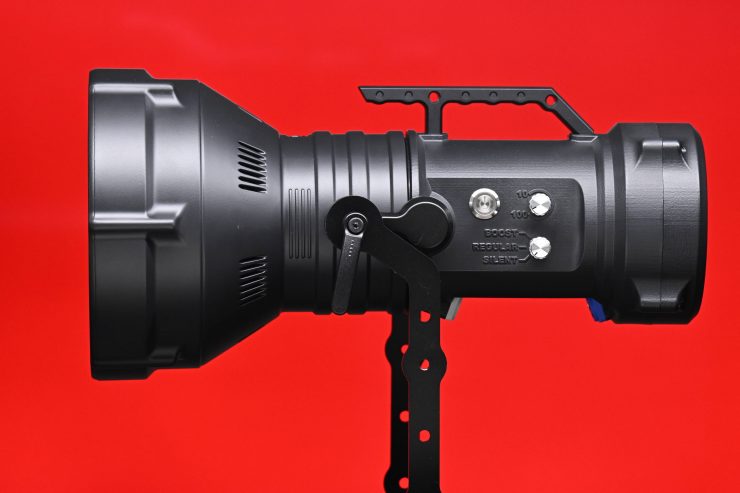
The Maxima 6 GaN now joins the Maxima 3 that I previously reviewed on the site.
The Maxima 3, was a well-made, well-thought-out fixture with exceptionally good color accuracy, and a decent amount of output. I liked the all-in-one design and the attention to detail.
While the Maxima 3 really impressed me, and it did a lot of things really well, there was room for improvement.
So without further ado, let’s get on with the review.
What is GaN?

The Maxima 6 GaN is the world’s first LED lamp driven by gallium nitride circuitry, which makes it capable of having a very high lux-to-weight ratio, best-in-class efficiency, and high CRI color rendition. GaN semiconductors are inherently more efficient than silicon, so less energy is expended as heat, resulting in a more efficient system with a higher power density (smaller volume).

According to Maxima, the patented, full copper heatsink combined with advanced thermal management puts Maxima 6 GaN at the top levels of performance charts, both in terms of brightness and compactness.
The increased efficiency obtained with GaN circuitry and the innovative thermal management subsystem is claimed to guarantee consistency and peak performance for years.
Thanks to the Gallium Nitride circuitry, you can operate the Maxima 6 GaN with any third-party DC source (like Bebop, FXLion, ARRI, etc.) from 35 to 75 V.
Gallium Nitride is a binary III/V direct bandgap semiconductor that is well-suited for high-power transistors capable of operating at high temperatures. Since the 1990s, it has been used commonly in light-emitting diodes (LED). Gallium nitride gives off a blue light used for disc-reading in Blu-ray. Additionally, gallium nitride is used in semiconductor power devices, RF components, lasers, and photonics. In the future, we will see GaN in sensor technology.
In 2006, enhancement-mode GaN transistors, sometimes referred to as GaN FETs, started being manufactured by growing a thin layer of GaN on the AIN layer of a standard silicon wafer using metal organic chemical vapor deposition (MOCVD). The AIN layer acts as a buffer between the substrate and GaN. This new process enabled gallium nitride transistors to be producible in the same existing factories as silicon, using almost the same manufacturing processes. Using a known process allows for similar, low manufacturing costs and reduces the barrier to adoption for smaller transistors with much-improved performance.
To further explain, all semiconductor materials have what is called a bandgap. This is an energy range in a solid where no electrons can exist. Simply put, a bandgap is related to how well a solid material can conduct electricity. Gallium nitride has a 3.4 eV bandgap, compared to silicon’s 1.12 eV bandgap. Gallium nitride’s wider band gap means it can sustain higher voltages and higher temperatures than silicon MOSFETs. This wide bandgap enables gallium nitride to be applied to optoelectronic high-power and high-frequency devices.
The ability to operate at much higher temperatures and voltages than gallium arsenide (GaAs) transistors also makes gallium nitride ideal power amplifiers for microwave and terahertz (ThZ) devices, such as imaging and sensing, the future market mentioned above.
ADVANTAGES OF GALLIUM NITRIDE
The value proposition for GaN devices consists of four major points:
Reduced energy costs – Because GaN semiconductors are inherently more efficient than silicon, less energy is expended as heat, resulting in smaller system sizes and material costs.
Higher power density (smaller volume) – Higher switching frequencies and operational temperatures than silicon result in lower cooling requirements, smaller heat sinks, conversion from liquid-cooling to air cooling, eliminating fans and reduced magnetics.
Higher switching frequency – The higher switching frequencies for GaN devices allow smaller inductors and capacitors to be used in power circuits. The inductance and capacitance scale down in proportion to the frequency – a 10X increase in frequency produces a 10X decrease in the capacitance and inductance. This can result in an enormous decrease in weight and volume, as well as cost. In addition, higher frequency can result in less acoustic noise in motor drive applications. High frequency also enables wireless power transfer at higher powers, more spatial freedom and bigger transmit to receive airgaps.
Lower system cost – While GaN semiconductors are generally higher cost than silicon, system-level cost reductions result through the use of GaN by reducing the size/costs of other components such as passive inductive and capacitive circuit elements, filters, cooling, etc. Savings range from 10-20%.
Compatible with all Profoto RFI, Bowens S mount accessories & the ARRI QLM system

The Maxima 6 GaN is natively compatible with all Profoto RFI and Bowens S mount accessories.
S-Mount locking ring

The Maxima 6 GaN comes with an S-Mount locking ring that allows you to attach Bowens mount lighting modifiers. Essentially it is like a PL mount for your light.

This is no ordinary Bowens mount. The interface was designed and built by Maxima because they didn’t think that any of the off-the-shelf adapters were good enough.

The Maxima 6 GaN’s S-Mount locking ring features a bayonet mechanism which provides a lot stronger and secure mounting platform than a standard Bowens mount.
The mount is so strong that you can pick up the entire light via an attached reflector without any fear of it breaking or falling off.
The other nice aspect about having a Bowens mount adapter is that you can just leave it attached to your softbox or lighting modifier.
Again, the attention to detail of this fixture is impressive.
ARRI QLM

In another industry first, it is also compatible with the ARRI QLM system. This allows you to attach a wide array of ARRI Orbiter optics to the fixture. Although it won’t allow you to use ARRI’s Fresnel that works with the Orbiter.

Now, to use the ARRI QLM mount you have to remove the Hyperbolic lens from the front of the fixture. You do this by undoing four Allen key bolts that hold the Hyperbolic lens and retainer ring in place.

Once the ring is off you need to remove the Hyperbolic lens itself. You need to do this because if you don’t, the Hyperbolic lens could cause serious damage to both lamps and optics.

It is best to think of this as shimming a lens. You need to have the correct collimation between the QLM mount adapter and the COB LED to prevent overheating. You should NEVER use any QLM accessory with the Hyperbolic lens attached.
There is also no need for an adapter for Profoto accessories since they will fit natively to the OmniMount.

A Fresnel lens will come as an accessory by the end of 2023.
Weight & Size

The Maxima 6 GaN weighs 4.6kg / 10.14 lb with its yoke frame. This is an incredibly low weight for a 600W LED spotlight.
As a comparison, the Maxima 3 weighs in at 3.5kg / 7.71 lb. With the Fresnel, it weighs 4.8kg / 10.58 lb. With the light head, Fresnel, and yoke frame it weighs in at 5.4kg / 11.9 lb.
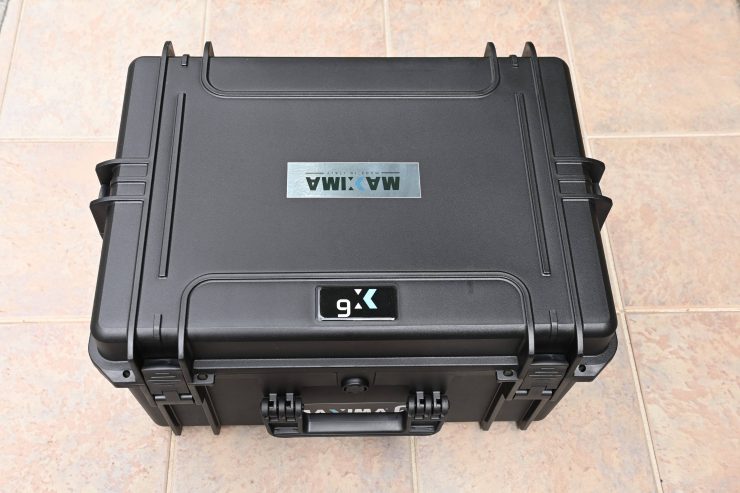
The Maxima 6GaN in its hardcase weighs 11.6 kg / 25.57 lb.

The Maxima 6 GaN is pretty compact in size because there is no additional power supply/controller. It is very lightweight considering its power draw and output. This all-in-one design makes it an appealing prospect for anyone who travels a lot.

What is also nice is that the light is very well balanced and you can hold the handle with one finger.
So how does the weight compare to some other spotlight fixtures that draw around 600W?
| TOTAL WEIGHT | |
| Maxima 6 GaN | 4.6 kg / 10.14 lb (Fixture with Yoke) |
| ARRI Orbiter | 11.7 kg / 25.79 lb (without Yoke) |
| Prolycht Orion 675 FS | 11.1 kg / 24.5 lb (Fixture with Yoke) |
| Aputure LS 600d Pro | 10.44 kg / 23.01 lb (with yoke and power supply) |
| Godox Knowled M600D | 8.48 kg / 18.69 lb (with yoke and power supply) |
| Nanlite Forza 720 Daylight | 9 kg / 19.84 lb (with yoke and power supply) |
| Kelvin Epos 600 | 12.18 kg / 26.85 lb (with yoke and power supply) |
| FotodioX Pro Warrior 600 Daylight | 10.61 kg / 23.4 lb (with yoke and power supply) |
| CAME-TV Tioga Series 660W Daylight | 10.49 kg / 23.12 lb (with yoke and power supply) |
As you can clearly see, the Maxima 6 GaN weighs considerably less than any other competing light on the market.
I found the lack of size and weight of the Maxima 6 GaN to be one of its biggest drawcards. It’s nice to have an all-in-one fixture that doesn’t weigh too much and doesn’t need an additional power supply/controller box.
The fixture is designed and manufactured in Italy and it comes with the addition of a 2- year warranty.
Concept

The whole concept behind the Maxima 6 GaN was to build a rock-solid, reliable, all-in-one workhorse fixture for industry professionals. Just like the Maxima 3, the Maxima 6 GaN was envisaged and brought to market by working professionals in the industry. Maxima is the brainchild of Enrico and Claudio who both work at cinestudio in central Italy. They originally made fixtures for themselves, but then because they became so popular customers started requesting to buy them, and from there a new company was born. The company is based in the Netherlands, but the manufacturing is entirely done in Italy.

When they were envisioning the Maxima 6 GaN they wanted to make something that was different from what was currently available in the market. There are hundreds of lights available and there is little point in making a light that is exactly the same as something that already exists. While there are always going to be some similarities with other point source lights, nobody wants to see a blatant copy of something that already exists.

The Maxima 6 GaN had to meet certain goals such as high build quality, high performance, and good usability because it is being targeted at high-end professionals.
If you are going to make a big investment in a lighting fixture, you want that lighting fixture to have a long shelf life. This is especially true for rental houses.
Build Quality

The build quality of the Maxima 6 GaN is extremely good. It has a very industrial feel to it and the entire light is manufactured in Acqualagna PU, Italy. The only component that doesn’t come from Italy is the LEDs that come from Japan.
The benefit of making almost everything in-house is that you aren’t relying on other companies and supply chains. This gives you greater control over your product when it comes to quality control, and you aren’t waiting on stock to come out of some other country.
Every Maxima 6 GaN fixture is hand-built from start to finish by one single engineer. The person who built the fixtures has his or her name placed on the tag that is attached to the light. Every Maxima 6 GaN is hand-tested for 80 hours before it can be signed off to be sent out to a customer. I don’t know of too many lighting companies, if any, that do this.
As part of the 80 hours of testing, the lights also get subjected to a weather test.

The Maxima 6 GaN utilizes a proprietary copper heatsink which was designed and manufactured by Maxima in Italy. The copper heatsink is claimed to provide a 40% more efficient luminous performance compared to aluminum heatsinks that are used by standard LED lamps.

The other benefit of utilizing a full copper heatsink is that Maxima can run in a silent mode up to a certain wattage and then even when the fan is activated at higher power draws it is claimed to be very quiet. COB LEDs run extremely hot and you need to cool them in an efficient way without creating a lot of noise.
ARRI fixtures are extremely popular in rental houses across the globe, and some of the primary reasons for that are long-term reliability and durability and I think Maxima is utilizing some of those same principles.

The nice aspect of the Maxima 6 GaN as I mentioned earlier, is that it is a self-contained unit. There is no separate controller or power supply that you have to tangle with. As the fixture isn’t super heavy, you can use it on a lot of different lighting stands, which is a big help, especially if you are traveling.

Every Maxima also comes with a nice card that details the company’s philosophy and it includes a sticker on the back with the direct email address for the person who will help you out if you have any questions or issues with the fixture. These little touches and the attention to detail tell you that the company cares about its product and the end user.

The included hard case is very well made and it is nice to see a company giving you a proper hard case instead of some cloth bag where the straps and zippers can potentially break.

What I also like is that unlike the Maxima 3, with the Maxima 6 GaN, you can put the light in the case with the yoke frame attached. This makes it a lot quicker to use out of the box.
Design

As far as the design goes, the Maxima 6 GaN doesn’t particularly look like anything else on the market. Its form factor is a little bit different from most other point source fixtures. It has a very space-age, industrial feel to it which I personally like.

It is very clear, at least to me, that the Maxima 6 GaN was made and designed by people working in the industry. Everything has been well thought out from a user perspective and that shows in the product. Often you can tell when an engineer has had too much say in the design of a product because they don’t factor in a user’s end experience. Design and usability need to work hand in hand to create a good product. I like companies or people who aren’t afraid to think out of the box and come up with something unique and different.

I like how they have placed both the power input on the Maxima 6 GaN at an angle underneath the fixture. This prevents any moisture or water from getting inside and it helps with creating a good balance when the light is mounted on the yoke frame.

I also like that the power cable is color-coded with its corresponding input. This may be a small thing but it shows attention to detail.
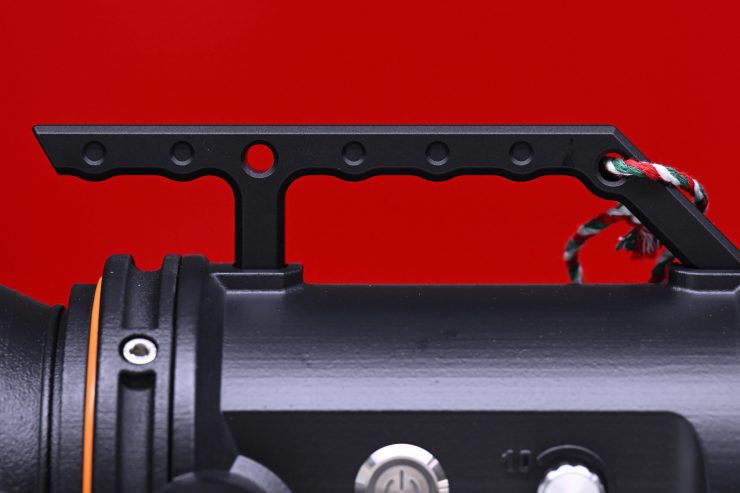
I also like the top handle on the fixture. It is beautifully made and it has been positioned so that the weight balance is even when you pick it up. Again, and I am going to keep stressing this in the review, the attention to detail is extremely impressive.
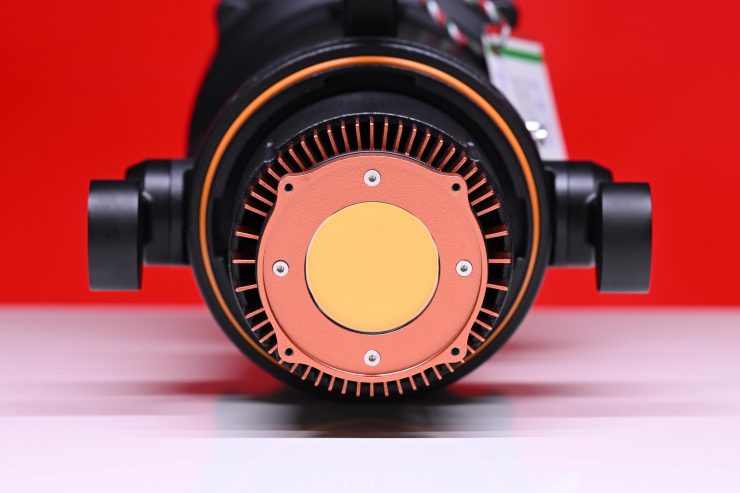
Quite a few LED spotlights on the market, including the Maxima 3, are using COB technology. COB stands for “Chip On Board” where multiple LED chips are packaged together as one lighting module. The advantage of COB LEDs being multi-chip packaged is that the light-emitting area of a COB LED can contain many times more light sources in the same area that standard LEDs could occupy. This results in a greatly increased lumen output per square inch.
The biggest problem with COB LED lights is that unless you diffuse them they are very bright to look at and unsuitable for directly lighting talent.
The light is flicker-free up to 200,000fps.
Hyperbolic Lens

On the front of the Maxima 6GaN and positioned after the COB is a Hyperbolic Lens.
The purpose of the Hyperbolic Lens was to make a removable optic that was designed to help concentrate and better fill the light rays inside certain kinds of open face optics and softboxes.
Because it has a curved dome, it can flood more light out toward the sides.
You can remove the Hyperbolic Lens and just use the Maxima 6 GaN without it if you wish. By doing this you end up with a very wide 120-degree beam.
Mounting
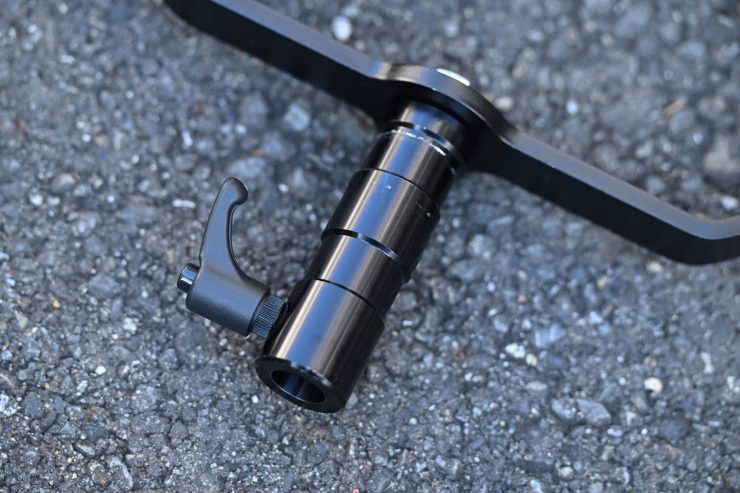
The yoke features a combination 1- 1/8″ Junior pin that you can also use on a regular spigot. This allows for a multitude of different ways to mount the light to various lighting stands depending on your requirements.

The yoke frame is not only very lightweight but incredibly sturdy. As I mentioned earlier, unlike the Maxima 3, you don’t need to remove the yoke frame from the fixture every time you want to pack it away.

The yoke frame has plenty of clearance so you can angle the Maxima 6 GaN completely down.
The way the Maxima 6 GaN has been designed, is that the yoke frame sits almost in the middle of the fixture so this provides a very good weight balance. You have to love the Italians, it is almost the same concept as building a sportscar where you try to get a 50/50 weight balance.
Even if the tightening knobs aren’t locked down the Maxima 6 GaN won’t suddenly fall down. It is this sort of attention to detail that I like.
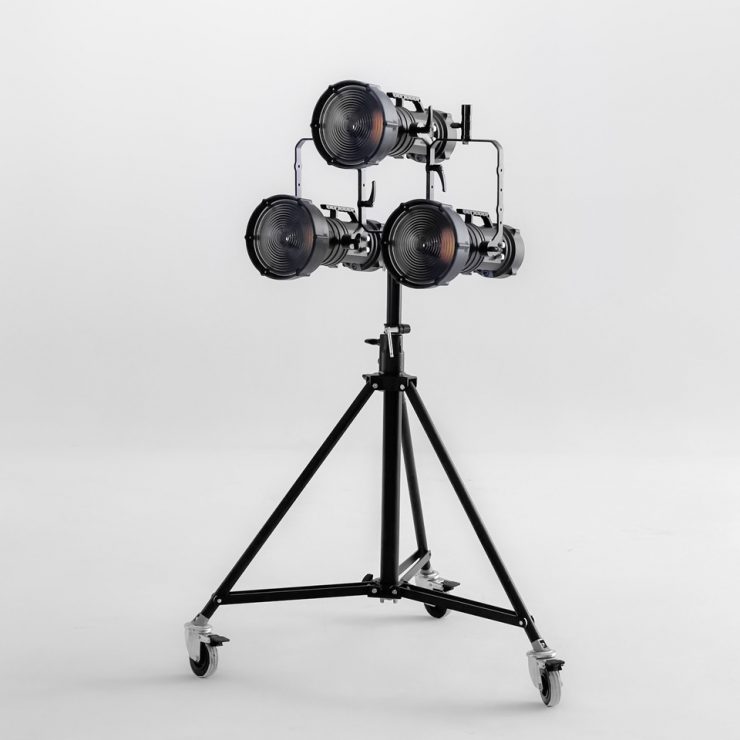
You will also notice that the yoke frame has a lot of holes in it. The reason for this is that you can attach other Maxima units so you can create larger arrays.
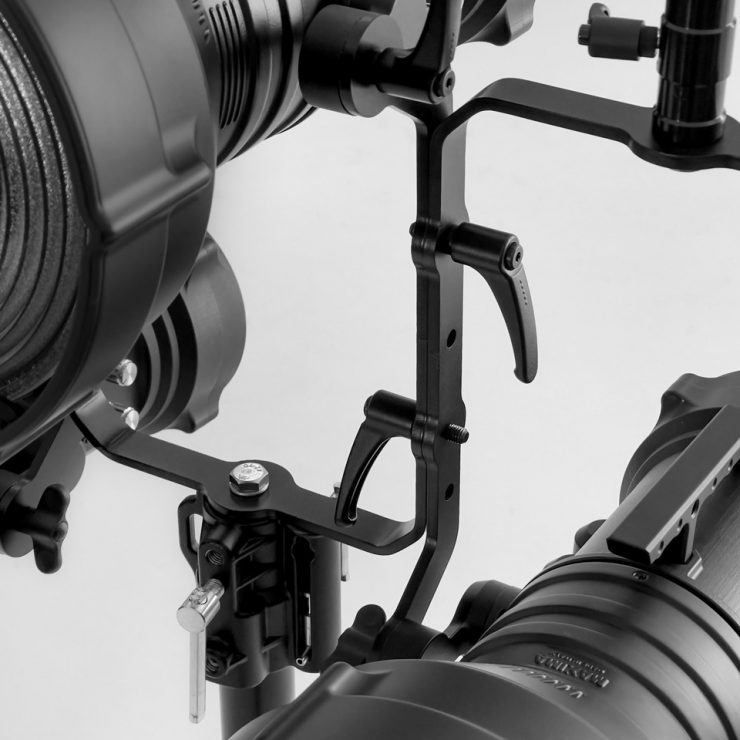
The way it works is that you can use the standard yoke frame that comes with the Maxima 6 GaN or Maxima 3 and attach another yoke frame directly to it. You simply turn another yoke frame upside down and then screw in the two locking mechanisms from the yoke mount to connect the frames. You then take two small M8 screws and insert another Maxima into the frame.
I like this design and the simplicity of what they have done here. Instead of having to buy additional array mounts, you simply use what you already have to create arrays. Everything has been well thought out.
Power Draw

The Maxima 6 GaN draws a maximum of 600W. It is almost strange that we keep talking about lights based on their power draw because all it essentially means is how much power is being drawn by that particular fixture. The power draw is never a direct correlation with how much output or how efficient a fixture is.

The Maxima has two power inputs located on the underside of the fixture. The blue one is for mains power and the white one is for the optional battery which I will talk about more in a minute. The Maxima 6 GaN utilizes PowerCon connectors.

So how does the power draw compare to some other spotlight fixtures that could be considered competition?
Below you can see how the price compares to some of the competition:
| MAX. POWER DRAW | |
| Maxima 6 GaN | 600W |
| ARRI Orbiter 30° Set | 500W |
| Prolycht Orion 675 FS | 675W |
| Aputure LS 600d Pro | 720W |
| Godox Knowled M600D | 740W |
| Nanlite Forza 720 Daylight | 800W |
| Kelvin Epos 600 | 720W |
| FotodioX Pro Warrior 600 Daylight | 600W |
| CAME-TV Tioga Series 660W Daylight | 660W |
You can also power the Maxima 6 GaN using its 35-75V DC PowerCon input.
Now, if you are using an external DC battery source, you may not be able to reach 100% output as it will depend entirely on the quality and specifications of the battery source you are using.
| V | A |
| 35V | 15A |
| 48V | 10A |
| 75V | 7A |
Above you can see what minimum capacity (A) is needed for typical voltages when powering the Maxima 6 GaN.
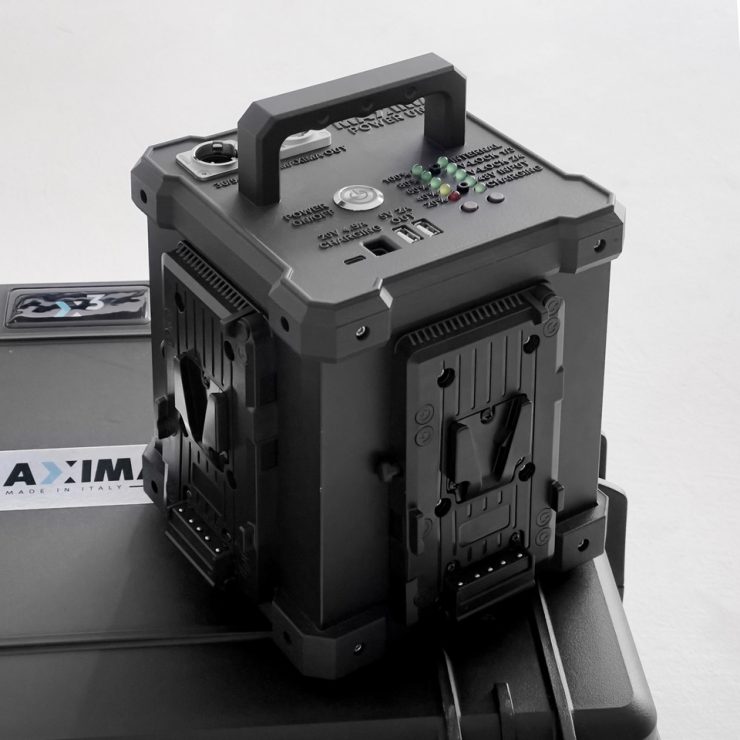
Maxima also makes an optional battery-powered solution that not only has a built-in 400Wh battery, but you can also attach up to 4 V-lock batteries. This solution lets you power the Maxima 6 GaN at up to 300W (about half power). You can utilize the internal battery or you can switch to running it via V-lock batteries. It also features a 36-54V DC input so you can also attach a big block battery. There is also a 5V out USB if you need to charge your phone, etc. I really like this concept as it gives you a lot of versatility, however, it isn’t a solution you can fly with.
You can charge the internal battery by using a regular Apple MacBook Pro charger that has USB-C. It takes around 4 hours to charge the internal battery according to Maxima.
I wasn’t able to test this power unit out at the time of doing this review.
Connectivity

The Maxima 6 GaN has both DMX In and DMX Out.
Controls & Operating Modes

The Maxima 6 GaN has been designed to be simplistic and easy to use. Because this is a daylight-only fixture you don’t need to have a lot of complicated menus or operating modes like you would with an RGBWW fixture.
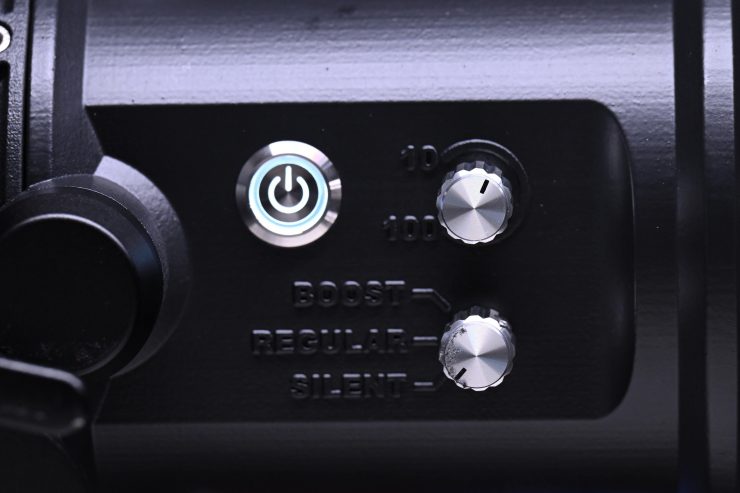
I like that when the fixture is connected to a power source, the power On/Off button is illuminated.
There is a simple on/off button, a Mode switch, and a Dimming dial. It is Italian simplicity. Sometimes there is no need to make anything more complicated than it needs to be. The only issue I have with the controls is that the Mode switch and Dimming dial are very difficult to see in dark conditions. You also have no way of seeing what the output level is. I would have much preferred to have seen some more marking on the fixture where I could see what percentage, or at least an indication, of what output the light was being set at. I couldn’t, for example, tell a gaffer to dim it down by 10% because there is no way of knowing what 10% less would be without pulling out a light meter.
There are 3 operating modes available on the Maxima 6 GaN:
SILENT MODE
In silent mode, Maxima 6 GaN operates in the 0-350W range and it is claimed to emit only 19dBa of noise. This is stated to be the best mode when silent operation is of paramount importance. Just to be clear, the fan does still work in this mode, and it is not completely silent. In this mode, the LEDs are also working at their best efficiency.
REGULAR MODE
In regular mode, the Maxima 6 GaN can operate in the 10-450W range and it is claimed to emit only 26dBa of noise. This is the most balanced ratio between luminous output and noise. Now, I did find that the fan noise when in this mode can be an issue if you have the fixture too close to where audio is being recorded. I found that as long as you have the light at least 2-3 meters away it won’t be any real issue.
BOOST MODE
In boost mode, the Maxima 6 GaN operates at its full power between 450-600W for those scenarios where audio is not being recorded or Maxima is placed far from the scene. This mode is exceptionally noisy and you couldn’t use it even remotely close to where audio is being recorded.
I like the Silent Mode because a lot of times when you are doing interviews you don’t want to run a light in an Auto fan mode where it is silent and then it suddenly kicks in 10 minutes into the interview. The output in Silent Mode is also high enough for a lot of indoor interview scenarios. It’s actually quite ironic that you see so many people running high-powered fixtures at 5% or less. You really don’t need a 600W fixture for an indoor interview, despite what marketing departments want you to believe. There are also quite a few fixtures on the market where the CCT accuracy drops when you start dimming a fixture down. People assume that nothing changes when you dim the light down and that is why I always test the light’s CCT performance at various dimming levels.
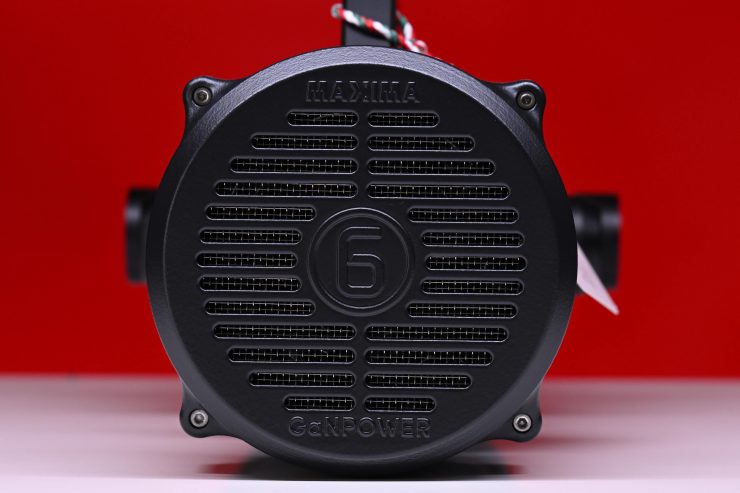
The caveat when designing a COB spotlight without a separate power supply/controller is that you are in a constant tug of war with the heat it produces. Having all of the components in an all-in-one design does mean that you are going to have to run fans and pretty high speeds if you want to power the light at higher outputs. While I love the Silent mode, I found the Regular mode was borderline as far as the amount of noise it created if you wanted to use the fixture in a quiet room for an interview. The Boost mode is very, very noisy, and you simply can’t use this if you are recording audio within 5-7 meters of where the fixture is positioned.
How loud is it?
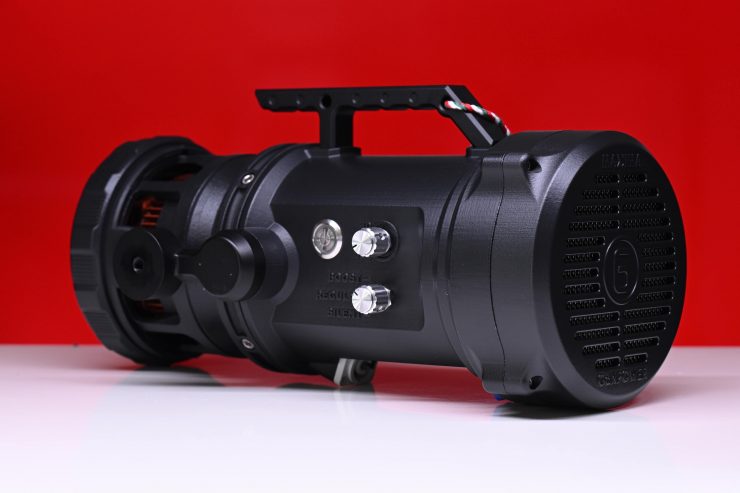
I did a few tests to see how much noise the Maxima 6 GaN generated at a distance of 3m / 9.84′.


Silent Mode 
Regular Mode 
Boost Mode
Above you can see some measurements I took at the various settings. Now, these measurements don’t really tell the whole story about the noise, so below you can hear what the various settings sound like when I recorded audio directly 1m /3.3′ in front of the fixture in the Silent, Regular, and Boost modes.
The Silent mode is reasonably quiet. In the Regular mode, you probably want to have the fixture around 2-3m away from where any audio is being recorded. In the Boost mode, you don’t want to have any audio being recorded within at least 5-7 meters. I personally wouldn’t use the Boost mode in any situation where critical audio is being recorded.
Maxima Control iOS & Android App

If you want you can use the free Maxima Control app that is available for iOS and Android devices. This app gives you full wireless control over the fixture.

The app is very straightforward to use and operate. Set up and pairing are extremely quick. All you need to do is turn the light on, open the app, select the fixture and that’s it.
There are several different pages that you can access in the app.

The Maxima Control Home page lets you turn the fixture On/Off and you can switch between the three different operating modes.
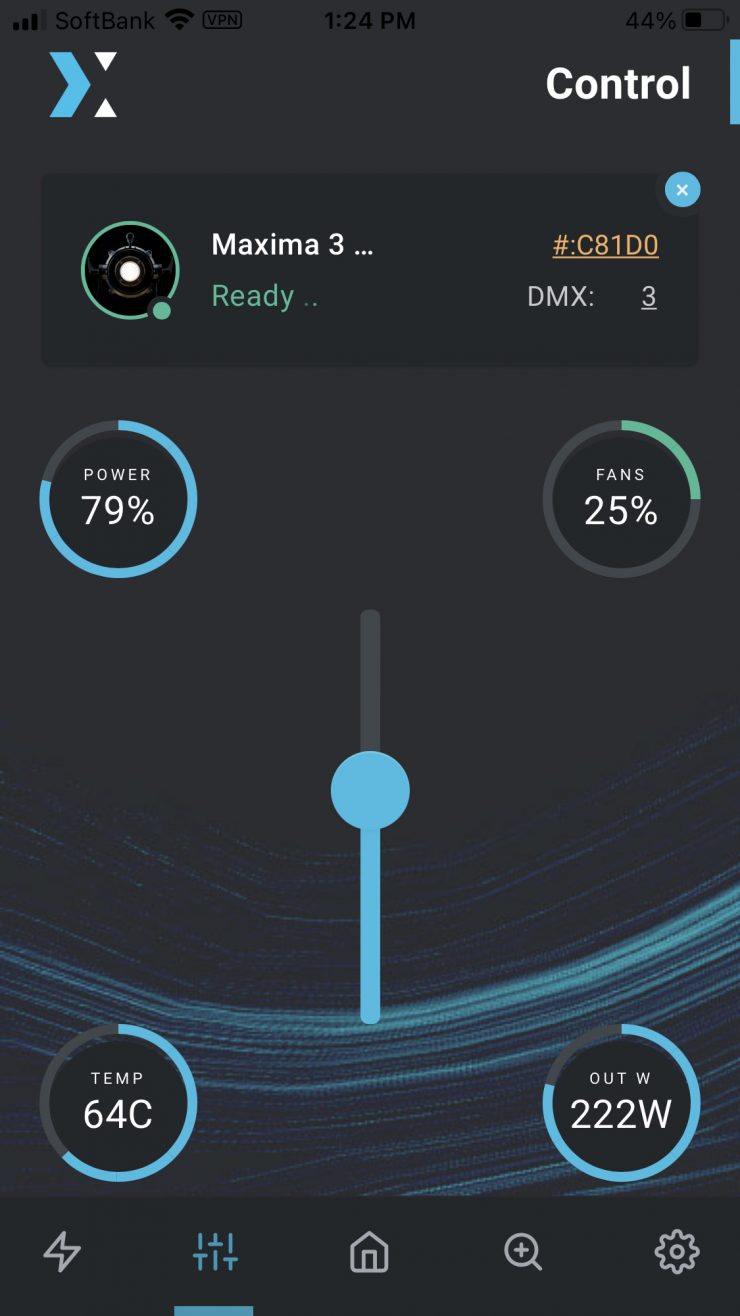
On the Control page, you will see a simple slider for adjusting the intensity, the status of the fans, and the temperature and output draw of the fixture.

You can access the Silent, Regular, and Boost modes quickly with a simple tap of the screen. There are up and down icons to adjust the intensity. I would have preferred to have seen sliders used here because you can’t tell what level of intensity you are at.
I would have also liked to have seen some preset intensity buttons so you could quickly move the light between various settings such as 25%/50%/75% etc. I would have also liked to have seen an indicator on this page that tells you what operating mode you are in.

On the Effects page, you can choose from several different effects, which can all be individually adjusted.

On the Device Info page you can the status of the light and what firmware version it is running, etc.

On the Settings page, you can choose to turn On/Off Auto-reconnect, put the light in Demo mode, and even open a Support ticket if you have an issue with the light.
The app works reasonably well, and to Maxima’s credit they have improved it since the Maxima 3, but there is certainly room for further improvement.
But it is only 5600K

In an age where RGBWW fixtures have become increasingly popular, some readers may well question the validity of owning a 5600K fixture. That is certainly a legitimate concern, however, we used tungsten and daylight-only fixtures for decades and that never held us back. Sure, a daylight-only fixture is not going to be as versatile as an RGBWW one, but it really depends on your use case requirements as to whether or not you need RGBWW.
Photometrics

So now let’s get to the photometric results. I always test lights in this way so that I get a reference to how they compare to other fixtures. Results only tell part of the story and should never be used alone to judge a light. I have found from extensive testing over the years that certain lights that have good photometric results don’t always look good, and lights that have worse photometric scores can sometimes look better than their results indicate.
You need to look at a whole series of photometric tests to come to a conclusion. You can’t make any accurate assessment by looking at one individual test. You wouldn’t just read one chapter in a book and know the entire story, so don’t do it with light results either!
Output & CCT Accuracy

Above you can see the claimed maximum output of the Maxima 6 GaN when it is used open face, with its 70-degree reflector, and with the ARRI QLM 15 and 30-degree optics.
If you want a comparison when it comes to output, the ARRI Orbiter when using its 15-degree QLM optic puts out 85,400 lx (7930 fc) @1m /3.3′. The claimed output of the Maxima 6 GaN using that exact same optic is a whopping 283,500 lx at the same distance.
I tested the Maxima 6 GaN using a Sekonic C-800 Spectrometer to find out how much output the light had and how accurate the CCT reproduction was.
So let’s see my independent testing results. All my readings were taken at a distance of 1m / 3.3′ in a controlled environment. I do all my testing using the same parameters so I can directly compare other lights. My figures are not going to replicate the manufacturer’s quoted figures because of the difference in testing methods. Also, because I am in Japan and the voltage is 100V, the figures I am getting, in theory, should be about 10% less because the light isn’t running on 230V power like it was when it was tested by the manufacturer.
Maxima 6 GaN Lamp 5600K Silent Mode

Above you can see the Maxima 6 GaN recorded an output of 18,200 lx (1690 fc) when using the lamp and running in Silent mode at a distance of 1m /3.3′.

The light recorded a CCT reading of 5695K which was reasonably decent.
Maxima 6 GaN Lamp 5600K Regular Mode

Above you can see the light’s output with its bulb and being used in its Regular mode. It produced 22,700 lx (2210 fc), which was 24.72% more than the 18,200 lx it produced when used in its Silent mode.

As far as CCT accuracy goes, it recorded a reading of 5686K.
Maxima 6 GaN Lamp 5600K Boost Mode

Above you can see the light’s output when using the bulb and set in its Boost mode. It produced 25,600 lx (2370 fc), which was 40.65% more than its output when in the Silent mode.
This was less than the 32,700 lx specified by the manufacturer, however, if we factor in the 10% loss of output because I am in a 110V country, then the difference between the actual output and the claimed output would be around 4000 lx.

As far as CCT color temperature accuracy goes, it recorded a reading of 5723K. This tells me that the Boost mode does slightly alter the CCT but only by around 30K.
Maxima 6 GaN 70° Reflector 5600K Silent Mode

Above you can see that when the fixture was using its 70° reflector and used in its Silent mode it recorded an output of 45,100 lx (4190 fc).

As far as its CCT reading was concerned, it recorded 5516K. What this shows me is that the 70° reflector does alter the CCT slightly by around 80K.
Maxima 6 GaN 70° Reflector 5600K Regular Mode

Above you can see the light’s output with its 70° reflector and used in its Regular mode. It produced 57,600 lx (5350 fc), which was 27.71% more than its output in Silent mode.

As far as CCT color temperature accuracy goes, it recorded a reading of 5506K.
Maxima 6 GaN 70° Reflector 5600K Boost Mode

Above you can see the light’s output with its 70° reflector and used in its Boost mode. It produced 65,700 lx (6100 fc), which was 45.67% more than its output in Silent mode.
This was less than the 82,150 lx specified by the manufacturer, however, even if we factor in the 10% loss of output because I am in a 110V country, then the difference between the actual output and the claimed output would still be around 8000 lx.

As far as CCT color temperature accuracy goes, it recorded a reading of 5507K. This shows me that CCT consistency when using the 70° reflector stays the same regardless of what mode you use.
Maxima 6 GaN Prolycht Orion 675 FS 30° Medium Beam Reflector 5600K Regular Mode
Just as another comparison I wanted to try using the Maxima 6 GaN with the Prolycht Orion 675 FS 30° Medium Beam Reflector to see how much output I could get.

Above you can see the light’s output with the Prolycht Orion 675 FS 30° Medium Beam Reflector and used in its Regular mode. It produced 114,000 lx (10600 fc), which was a ton of output.

As far as CCT color temperature accuracy goes, it recorded a reading of 5564K. This shows me that CCT reading actually improved when using the Prolycht Orion 675 FS 30° Medium Beam Reflector
Maxima 6 GaN Prolycht Orion 675 FS 30° Medium Beam Reflector 5600K Boost Mode

Above you can see the light’s output with the Prolycht Orion 675 FS 30° Medium Beam Reflector and used in its Boost mode. It produced 130,000 lx (12100 fc), which was a ton of output.
As a direct comparison, the output of the Prolycht Orion 675 FS using the 30° Medium Beam Reflector was 123,000 lx.

As far as CCT color temperature accuracy goes, it recorded a reading of 5610K, which was almost perfect. This shows me that CCT reading actually improves when using the Prolycht Orion 675 FS 30° Medium Beam Reflector
Maxima 6 GaN DoPChoice Softbox 5600K Silent Mode
I also wanted to see how much output the Maxima 6 GaN had when using it in conjunction with a DoPChoice softbox. All measurements were taken 1m / 3.3′ from the front of the softbox.

Above you can see that when the fixture was using a DoPChoice Octa 3 softbox and set in its Silent mode it recorded an output of 5190lx (482 fc).

As far as its CCT reading was concerned, it recorded 5465K. What this shows me is that the softbox was altering the CCT by around 130K. This is the biggest issue when using a fixed color temperature light because you can’t simply increase or decrease the CCT to make an adjustment.
Maxima 6 GaN DoPChoice Softbox 5600K Regular Mode

Above you can see that when the fixture was using a DoPChoice Octa 3 softbox and set in its Regular mode it recorded an output of 6710lx (623 fc)

As far as its CCT reading was concerned, it recorded 5452K.
Maxima 6 GaN DoPChoice Softbox 5600K Boost Mode

Above you can see that when the fixture was using a DoPChoice Octa 3 softbox and set in its Boost mode it recorded an output of 7830lx (727 fc)

As far as its CCT reading was concerned, it recorded 5451K.
Summary
So let’s table up those results so you can compare them all in one place.
Bulb
| OUTPUT | CCT | |
| Silent Mode | 18,200 lx | 5695K |
| Regular Mode | 22,700 lx | 5686K |
| Boost Mode | 25,600 lx | 5723K |
70° Reflector
| OUTPUT | CCT | |
| Silent Mode | 45,100 lx | 5516K |
| Regular Mode | 57,600 lx | 5506K |
| Boost Mode | 65,700 lx | 5507K |
DoPChoice Softbox
| OUTPUT | CCT | |
| Silent Mode | 5190 lx | 5465K |
| Regular Mode | 6710 lx | 5452K |
| Boost Mode | 7830 lx | 5451K |
What about if you start dimming the light down?
Nobody uses a light at 100% output every time they turn it on. It is important to test the CCT accuracy of a light when it is used at reduced outputs. It was hard to do any sort of accurate testing with the Maxima 6 GaN because it doesn’t give you any indication of exactly what percentage it is running at. The way I came up with a solution was to look at the power draw using the app when it was set at its maximum output and then work out what the percentage was based on that. I could then set the fixture to a certain power draw to get a reasonably accurate percentage reading.
Below you can see a series of tests at 100%/75%/50%/25%10% to see if the CCT being recorded changed. This was done at a distance of 1m using a Sekonic C-800. These tests were done at 5600K using the bulb in the Regular mode.
| CCT READING | OUTPUT | INTENSITY % |
| 5686K | 22,700 lx | 100 |
| 5727K | 16,700 lx | 75 |
| 5719K | 11,600 lx | 50 |
| 5748K | 5680 lx | 25 |
| 5760K | 1940 lx | 10 |
The Maxima 6 GaN’s CCT consistency was decent, but it could have been better. My testing showed that the CCT readings varied by 74K.
As far as how linear the output is when you start dimming the light, at 50% output it had 48.89% less output than when used at 100%. At 25% it had 74.97% less output than when used at 100%. At 10% output, it had 91.45% less output than when used at 100%. This shows me that the light’s dimming curve is very linear.
How does the output compare to some other fixtures we have reviewed?
It is hard to do apples-to-apples comparisons, but I will put figures down showing what various lights recorded when used open face and with their reflector. It is important to note that these lights have varying power draws and beam angles.
Open Face
| OUTPUT @1m | CCT | |
| Maxima 6 GaN Boost mode | 22,700 lx | 5686K |
| Maxima 6 GaN Regular mode | 25,600 lx | 5723K |
| Aputure LightStorm LS 600d II Pro | 25,600 lx | 5619K |
| Aputure LightStorm LS 600c Pro | 15,400 lx | 6139K |
| Prolycht Orion 675 FS | 17,000 lx | 5694K |
| Nantlite Forza 720 | 31,530 lx* | NA |
| Nantlite Forza 720B | 22,500 lx | 5674K |
*Not independently tested (manufacturers claims)
Reflector
| OUTPUT @1m | CCT | |
| Maxima 6 GaN Boost mode 70° Reflector | 65,700 lx | 5507K |
| Maxima 6 GaN Regular mode 70° Reflector | 57,600 lx | 5506K |
| Aputure LightStorm LS 600d II Pro 55° Hyper Reflector | 97,100 lx | 5728K |
| Aputure LightStorm LS 600c Pro 55° Hyper Reflector | 49,000 lx | 5617K |
| Prolycht Orion 675 FS 55° Reflector | 55,700 lx | 5515K |
| Nanlite Forza 720 55° Reflector | 124,000 lx* | NA |
| Nantlite Forza 720B 55° Reflector | 73,000 lx | 5397K |
*Not independently tested (manufacturer claims)
What you need to remember is that the reflector that comes with the Aputure LightStorm LS 300d II Pro has a massive hotspot, so the figures are a bit deceiving.
Again, I need to stress that these are not apples-to-apples comparisons because of the different power draws and beam angles. The Maxima 6 GaN reflector is 70° so that is quite a bit wider than the 55° of the other reflectors.
Color Rendering

So now that we have seen how much output the Maxima 6 GaN produces, how does it perform when it comes to replicating accurate color? The Maxima 6 GaN has a lot to live up to as its baby brother the Maxima 3 produced the best results I have ever seen from any LED light.
Maxima 6 GaN Bulb Regular Mode

Above you can see that when the light was used in its Regular Mode it recorded an average CRI (R1-R8) of 97.8 and an extended CRI (R1-R15) of 97.38. For replicating accurate skin tones it recorded 96.3 for R9 (red), 97.5 for R13 (closest to caucasian skin tones), and 97.0 for R15 (closest to Asian skin tones). Not a single value was below 95.2. These are outstanding results.
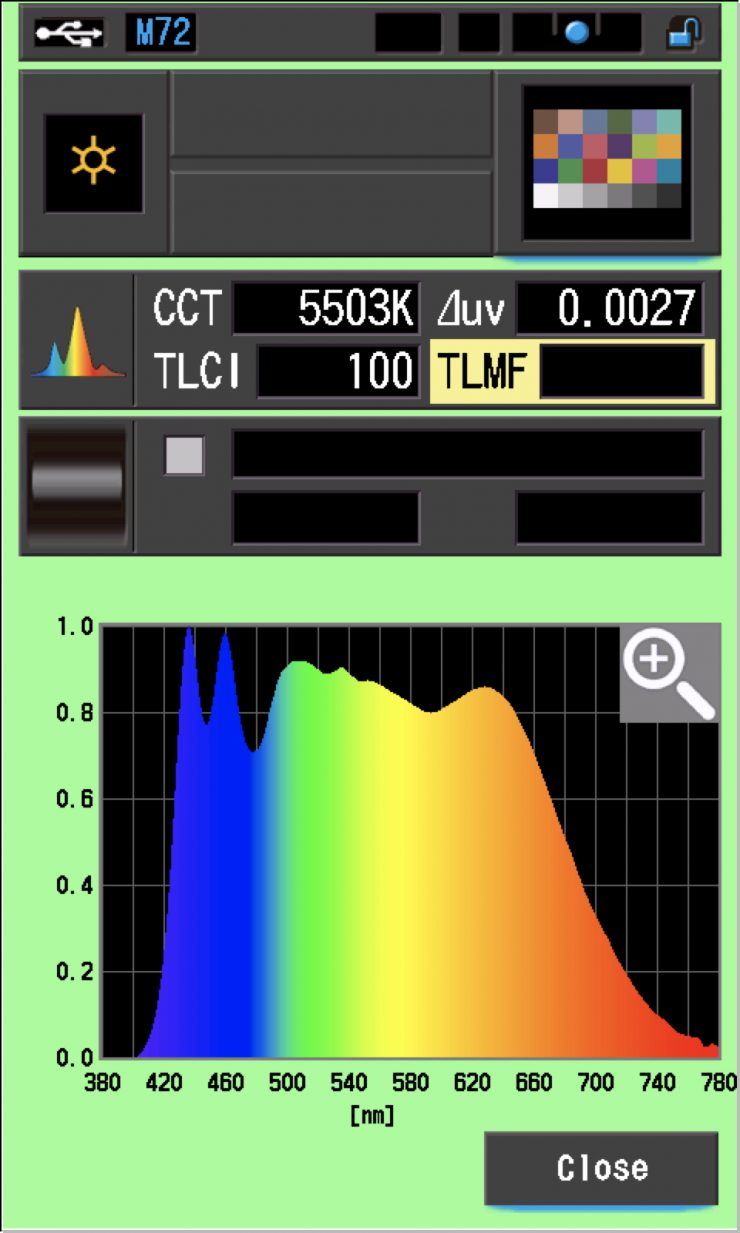
The light, when set at 5600K, recorded a TLCI score of 99.
These are outstanding results, but they weren’t quite as good as the results I got from the Maxima 3. As a comparison, below you can see the results from the Maxima 3.
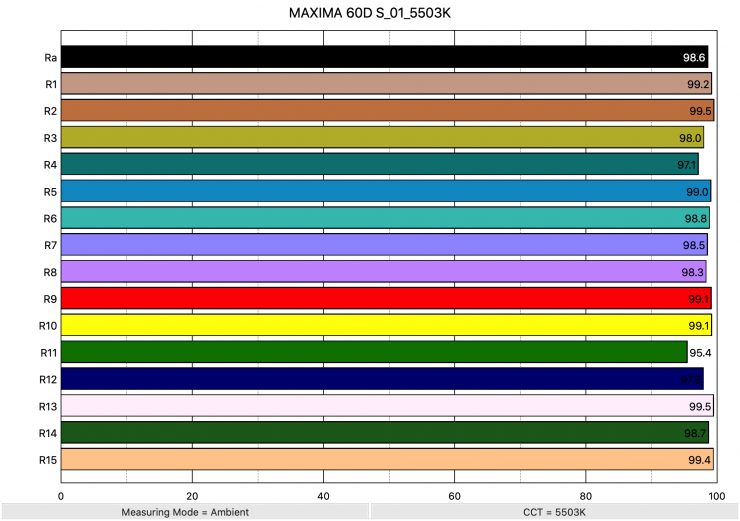
Above you can see that when the Maxima 3 was in its Silent Mode and set at 60° it recorded an average CRI (R1-R8) of 98.6 and an extended CRI (R1-R15) of 98.5. For replicating accurate skin tones it recorded 99.1 for R9 (red), 99.5 for R13 (closest to caucasian skin tones), and 99.4 for R15 (closest to Asian skin tones).
The results from the Maxima 3 were the best results I have ever seen from a LED spotlight period. Every Ra value was above 95 and the lowest score was 95.4. The extended CRI (R1-R15) of 98.5 was the highest score I have ever recorded from any light. This light is exceptionally accurate and the color rendering scores set a new benchmark.

The Maxima 3, when set at 5600K, recorded a perfect TLCI score of 100. This is the first light I have ever tested to receive a perfect score.
Maxima 6 GaN Bulb Boost Mode

Ok, so we have seen how good the color rendering scores are when the light is run in its Regular mode, but how does it perform in the Boost mode? Above you can see that when the light was in its Boost Mode recorded an average CRI (R1-R8) of 97.7 and an extended CRI (R1-R15) of 97.29. For replicating accurate skin tones it recorded 96.5 for R9 (red), 97.3 for R13 (closest to caucasian skin tones), and 96.9 for R15 (closest to Asian skin tones).
These results were pretty close to being identical to when the light is used in its Regular and Silent mode. This tells me that the light still remains exceptionally color-accurate no matter what mode you are running it in.

The light, when used in Boost mode, recorded a TLCI score of 99.
So how do these results compare to something like a Prolycht Orion 675 FS, Aputure LightStorm LS 600d II Pro, ARRI Orbiter, and the Maxima 3?
| EXTENDED CRI | R9 | R13 | R15 | |
| Maxima 6 GaN | 97.38 | 96.3 | 97.5 | 97.0 |
| Maxima 3 | 98.5 | 99.1 | 99.5 | 99.4 |
| ARRI Orbiter | 98.1 | 86.3 | 98.9 | 97.4 |
| Aputure LightStorm LS 600d II Pro | 93.4 | 98.6 | 98.9 | 97.3 |
| Aputure LightStorm LS 600c Pro | 94.68 | 93.9 | 98.9 | 96.2 |
| Nanlite Forza 720B | 97.08 | 92.7 | 98.9 | 97.1 |
| Prolycht Orion 675 FS | 94.19 | 79.0 | 96.5 | 93.2 |
Above you can see that the Maxima 6 GaN had the third-highest extended CRI and it was only marginally behind the Maxima 3 and ARRI Orbiter. In saying this, all of these lights I just mentioned perform very well when it comes to color rendering.
CC Index & ⊿uv
The CC Index displays the CC correction value and whether any magenta or green need to be added or subtracted. 1 CC corresponds to 035 Kodak CC values or 1/8 Rosco filter values. Any reading less than +1.00 or -1.00 and you’re probably not going to need to make any kind of adjustment. The ⊿uv is the value to show how much this light is away from being an ideal light source (black body radiation = incandescent lamp). As with the CC Index you want this number to theoretically be zero. Kelvin is not a linear value, so we need to convert from Kelvin to MK-1 to compare the values of color temperature. To calculate from Kelvin to Mired is MK-1= 1*1000000/Kelvin. While this may sound confusing, it is the only way of measuring if the Kelvin shift is significant enough to warrant having to use a filter for correction. Below are the results for the Maxima 6 GaN when using the Regular Mode.
Maxima 6 GaN Kelvin Vs MK-1
| Kelvin | Difference in K | MK-1 | Difference in MK-1 | |
| SET VALUE | 5600K | 0 | 178.57 | 0 |
| ACTUAL READING | 5686K | 86 | 175.87 | 2.7 MK-1 |
These figures might look confusing, but what it tells me is that the light is very CCT accurate. Any MK-1 score that is under -9/9 means you wouldn’t have to use any color correction gels. The MK-1 scores for this light were good. Any score under -6/6 is considered to be excellent.
CC INDEX & ⊿uv
| CC INDEX | ⊿uv | |
| 5600K | 0.0 | -0.0006 |
Again, this score is exceptionally good. The consistency of the Maxima 6 GaN is certainly what makes it stand out from a lot of other lights.
TM-30
TM-30 is a relatively new color rendering standard that was developed to deal with the limitations of CRI. TM-30 looks at 99 individual colors. These 99 colors are categorized into seven groups: nature, skin color, textiles, paints, plastics, printed material, and color systems.
TM-30 scores go from 0 – 100. The higher the score, the more accurate a light is at producing colors. Any TM-30 Rf score in the ’90s is considered to be good. What is interesting and something that you need to be very aware of is that two separate light sources with the exact same CRI scores can render colors very differently. A light with a high CRI rating could have a low TM-30 score. Conversely, a light with a good TM-30 score could have a bad CRI score.
Now, there are two measurements associated with TM-30, Rf and Rg.
Rf (Color Fidelity)
Rg (Color Gamut)
With Rf value, ideally, you want a score in the 90’s.
With Rg value, a score below 100 indicates that the light source renders colors with less saturation than the reference source. So ideally you want this score to be above 100.


Silent Mode 
Regular Mode 
Boost Mode
Above you can see the scores for Maxima 6 GaN. Below I have listed the figures as well.
| Rf | Rg | |
| Silent Mode | 97 | 102 |
| Regular Mode | 97 | 102 |
| Boost Mode | 97 | 102 |
The TM-30 scores are all good and it shows me that the light is very consistent at replicating accurate color with full saturation.
SSI
SSI (Spectral Similarity Index) was developed by the Sci-Tech Council of the Academy. SSI gives me the ability to set any light as a standard, or use predefined standards (such as CIE D55), and then give other lights an SSI score based on how well they will match standards such as CIE D55. This way I can measure spectral response and compare it directly against an ideal light source. This is actually a much better test than recording CRI scores.

In the graph above the gold bars indicate a perfect CIE D55 source. The red bars indicate a perfect CIE D 5600K source. This lets us compare how close to a perfect 5600K lighting source the Maxima 6 GaN is. A score in the low 70’s is typical for a 5600K LED source. A score in the 80s is outstanding. While 82 is a good score, the highest SSI scores I have ever recorded were with the ZOLAR 1×1 panels which recorded SSI scores of 90.
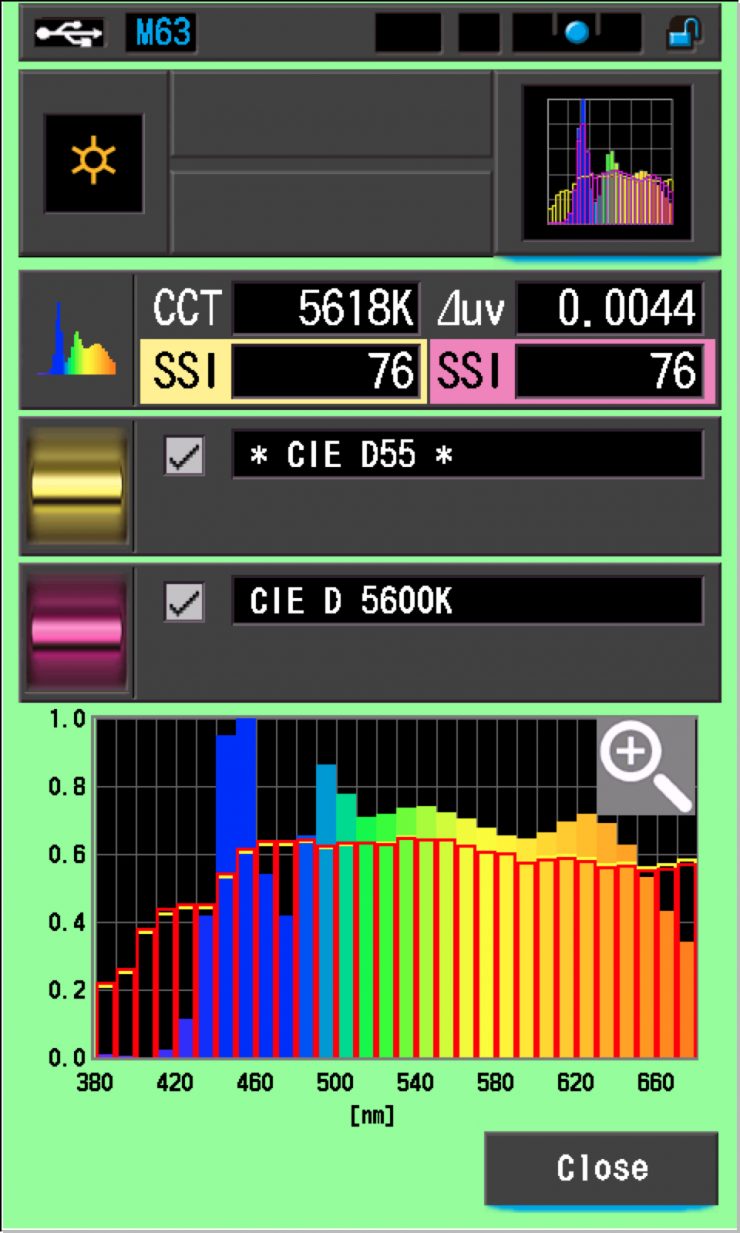
As a comparison, above is the SSI score for the very good ARRI Orbiter.
The main reason we want to record SSI scores is so we can see how well they match with other lights. As an example, I wanted to see how well the Maxima 6 GaN matched the Prolycht Orion 675 FS and the ARRI Orbiter. Below you can see the results.

As you can see neither lights are a perfect match to the Maxima 6 GaN, but they are reasonably close.
As another test, I thought I would compare the Maxima 6 GaN against the Intellytech MEGA-8 LITECLOTH 3.0 and the Godox KNOWLED F200Bi Flexible LED Mat.

As you can see, neither the Intellytech or Godox was a great match. In saying that, very few lights from different manufacturers are ever going to be an exact match. The problem with having a light that has very good color rendering scores is that it isn’t going to match a lot of other lights.
Ok, so how about if we test how well the Maxima 6 GaN matches itself when used with the 70-degree reflector and the DoPChoice Octa 3 softbox.

As you can see the light was almost a perfect match regardless of what lighting modifier you were using it with.
SSI tests are a great way of telling you what lights you own or use will work well together.
Spectral Distribution

Above you can see the spectral distribution of the Maxima 6 GaN. The spectral distribution is extremely full, and there aren’t any large spikes.
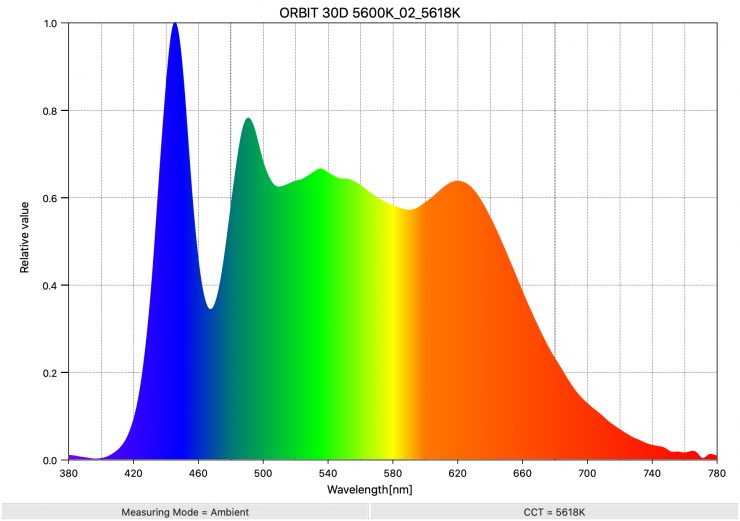
As a comparison, above you can see the spectral distribution of the ARRI Orbiter when it is set at 5600K. The spectral distribution is reasonably full, but you can see a green spike.
Real-World Performance, Usability & Quality of Light

As I always say, photometric scores only tell you part of the story. So let’s find out if the scores from the Maxima 6 GaN translate into good real-world performance.
The quality of the light that is coming from the Maxima 6 GaN is really nice, but like any fixture, how you use it is more important than what it can do.
The Maxima 6 GaN is a lot more compact and lightweight than competing fixtures with a similar power draw, this alone makes it an intriguing proposition for anyone who wants to keep their kit size to a minimum. Not having to connect up an additional power supply/controller was refreshing and because of the relatively low weight for a fixture with this output, you don’t have to use large heavy-duty light stands.
The ease of use that this fixture offers is impressive. Because it has been well thought out, nothing is overly complicated and it doesn’t take long to set up the light or put it away once you are done. Having everything fit into a single case is also a nice touch. In saying that, the optional 70-degree reflector and any other optional mounts won’t fit inside the case.
The light certainly has more than enough punch to work well for interviews, lighting up medium to large-sized rooms, etc., and creating a nice hard directional source when using reflectors or ARRI QLM optics. The versatility of being able to use the light as a hard or soft source is what makes spotlights such a popular option for owner/operators.


Boost Mode 
Regular Mode 
Silent Mode 
Light Off 
Position of the light
Above you can see comparisons where I punched the light without a reflector from outside through a sheer curtain.


Boost Mode 
Regular Mode 
Silent Mode 
Light Off
Above you can see comparisons where I punched the light using its 70-degree reflector from outside through a sheer curtain.

I also decided to do some tests using the Prolycht Orion 675 FS 30-degree reflector.


Boost Mode 
Regular Mode 
Silent Mode 
Light Off
Above you can see comparisons where I punched the light using the Prolychyt Orion 675 FS 30-degree reflector from outside through a sheer curtain.



Boost Mode 
Regular Mode 
Silent Mode 
Light Off
Above you can see comparisons where I punched the light without its reflector directly into a ceiling.
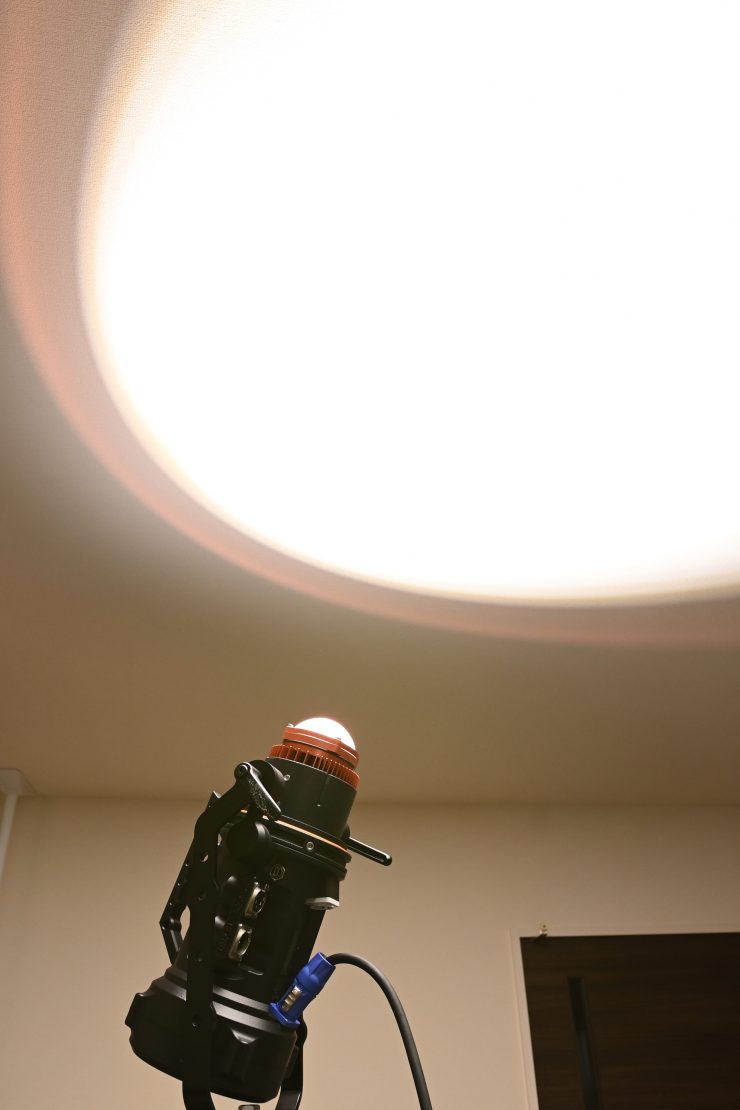
The slight issue with the bulb is that it does cast a color ring from the copper heatsink out at the edges of its beam. It doesn’t matter whether you are using the light with or without the Bowens S mount attachment.

Used without the reflector the dome is able to create nice shadows with no cross hatching.



Boost Mode 
Regular Mode 
Silent Mode 
Light Off
Above you can see comparisons where I am using the light without its reflector at a distance of 3m /9.9′ from a wall.



Boost Mode 
Regular Mode 
Silent Mode 
Light Off
Above you can see comparisons where I am using the light with its 70-degree reflector at a distance of 3m /9.9′ from a wall.

The 70-degree reflector does have a bit of a hot spot that you can see if I place the light close to a wall.

Above you can see that when you use a DoPchoice Rabbit Rounder Octa 3 it fills out the softbox nicely.

In combination with a large softbox, the Maxima 6 GaN is very capable of creating a nice wrapping soft lighting source.
Who is the Maxima 6 GaN aimed at and where does it fit in the market?
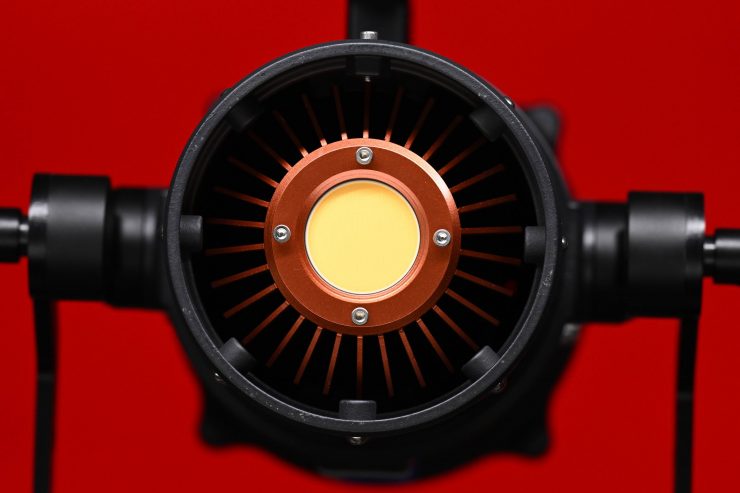
You could use the Maxima 6 GaN for lots of different lighting applications, but the fixture is certainly being targeted as a versatile, high-output, high-quality lighting fixture for professional use in the TV and film industry.
If you are an owner-operator who is looking for a jack-of-all-trades lighting solution, would the Maxima 6 GaN be something you should look at? The answer to that question really depends on your requirements. With its all-in-one design and compact size and weight, it does make for a good solution for owner/operators who don’t need an RGBWW or Bi-color solution. However, it is a little harder than other options to run remotely from batteries as it doesn’t come with a separate control/power supply box with battery plates. The fan noise is certainly of concern, at least to me, as I think in Boost mode it is too loud to be used when recording audio. Even in the regular mode, I would want to audio being recorded to be at least 3-5 meters away from the fixture.
While there is no doubt that it does a lot of things well, you could argue that similar power draw RGBWACL lights like the Prolycht 675 FS and Aputure LS 600c Pro are more versatile and you can run them directly via camera batteries from the included power supply/controller. However, the Maxima 6 GaN is arguably better built, it is well thought out, a lot lighter, and features an all-in-one design. There really is no such thing as the perfect light. There are pros and cons with every light. The best light is often the one that works well for your particular needs.
Whenever something new comes out there are always going to be questions asked such as, “Why do I need that?” and “Does this do anything that can’t already be done with something that I already own?”
Any potential buyer of a Maxima 6 GaN has to way up the cost, size, weight, and feature set against fixtures they may already own, or competing fixtures that offer different functionality.
The great aspect of the Maxima 6 GaN, like most spotlights, is that it has the ability to be a hard light source, a soft source, or just about anything else you want it to be.
Full Specifications

Price & Availability

The Maxima 6 GaN retails for €2,999, including the waterproof Flight Case and the Bowens adapter.
Below you can see how the price compares to some of the competition:
| PRICE | |
| Maxima 6 GaN | €2,999 ($3,290 USD) |
| ARRI Orbiter 30° Set | $3,855 USD* |
| Prolycht Orion 675 FS | $3,495 USD |
| Aputure LS 600d Pro | $1,890 USD |
| Godox Knowled M600D | $1,499 USD |
| Nanlite Forza 720 Daylight | $1,699 USD |
| Kelvin Epos 600 | $2,799 USD |
| FotodioX Pro Warrior 600 Daylight | $1,595.95 USD |
| CAME-TV Tioga Series 660W Daylight | $1,288 USD |
*Currently on sale at B&H
Just to reiterate, the Maxima 6 GaN doesn’t have a lot of the same features as the Orbiter, Orion 675 FS, or the Kelvin Epos 600.
The Maxima 6 GaN is a little on the expensive side and a lot of that is due to the fact that the light is manufactured in Italy and not China. The labor costs and the materials used are not the same as what you will find in more affordable fixtures. Also, none of these other fixtures utilize GaN technology.
Accessories

Maxima also sells a range of accessories for the fixture. Some of them can be seen above.
Conclusion

The Maxima 6 GaN, is a well-made, well-thought-out fixture with exceptionally good color accuracy, and a decent amount of output. I like the all-in-one design and the attention to detail.
The fixture produces a really nice quality of light and I like how quickly you can change it from being a hard to a soft source by using a myriad of lighting modifiers. The color rendering scores are extremely impressive and this translates into a really good quality of light. The output is pretty good, especially for a fixture of this size and weight. The ability to run a wide array of lighting modifiers, including ARRI QLM optics is something we haven’t seen before.
The interface and operating system are fairly straightforward and easy to use, and in that regard, it is a quick fixture to set up. I do wish that you could see exactly what the output was set at as this is bound to confuse some users.
The app is easy enough to use, but it could still be improved upon. What can catch you out with the app, is that when you are using it, it overrides whatever the positions are set at for intensity and operating mode on the fixture itself. For example, the light might be set in the Regular mode position at full output, but on the app, you have chosen Silent and around half output.
The only real downsides to the light are probably the noise it makes in Boost mode and the fact that it isn’t as easy to run remotely from camera batteries as some of the competition. The fan noise does limit the usability of the light and its output when working in environments where sound needs to be recorded. This is the caveat to having an all-in-one design and not using a separate power supply/controller.
Yes, the light is expensive, but it is going to be a fixture you could perceivably use for many, many years. It is built like a tank and it is going to stand up to the rigors of field use.

This is not a light for everyone and it is aimed at a specific audience. The same person looking at a Maxima 6 GaN isn’t going to be the same person looking at a lower-cost COB spotlight. For those who value color accuracy, build quality, and attention to detail, and are looking for something that is unique, the Maxima 6 GaN ticks a lot of boxes.
The Maxima 6 GaN is an impressive fixture and there is a lot to like. It is not perfect, but no light is. Maxima has paid a lot of attention to small details, but having an all-in-one design to minimize size and weight does come with its caveats.
It is good to see a small company coming out with lighting technology that hasn’t been used, at least to my knowledge, in our industry before. With so many copycat fixtures out there, the Maxima 6 GaN is a breath of fresh air.











